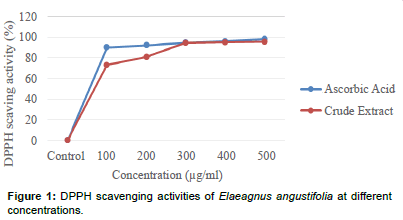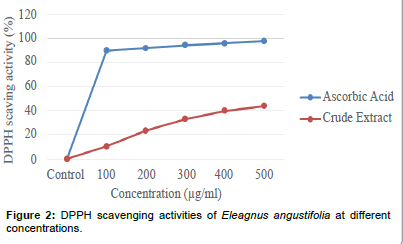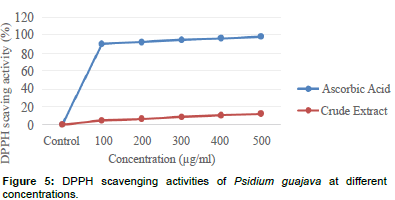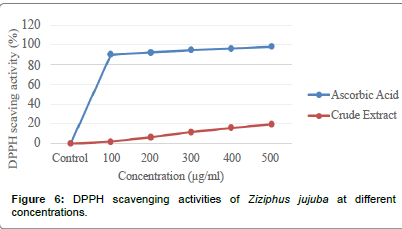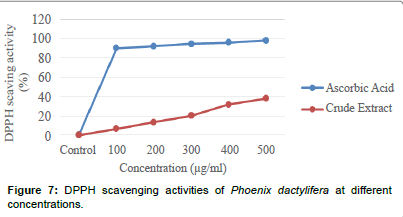Research Article Open Access
Antioxidant Activity of Selected Medicinal Plants of Pakistan
Taj Ur Rahman1, Tariq Khan2, Khanzadi Fatima Khattak1, Amjad Ali4, Wajiha Liaqat2and Muhammad Aurang Zeb3*
1Department of Chemistry, Abdul Wali Khan University, Mardan, Pakistan
2Institute of Chemical Sciences, University of Peshawar, Peshawar 25120, Pakistan
3Department of Biochemistry, Hazara University, Mansehra, Pakistan
4Department of Integrated Biosciences, Cecos University, Peshawar, Pakistan
- *Corresponding Author:
- Aurang Zeb M
Department of Biochemistry
Hazara University, Mansehra
Pakistan
Tel: 0092-300-59-61-093
E-mail: muhammad_aurangzeb@hotmail.com
Received date June 09, 2016; Accepted date July 21, 2016; Published date July 28, 2016
Citation: Rahman TU, Khan T, Khattak KF, Ali A, Liaqat W, et al. (2016) Antioxidant Activity of Selected Medicinal Plants of Pakistan. Biochem Physiol 5:208. doi:10.4172/2168-9652.1000208
Copyright: ©2016 Rahman TU, et al. This is an open-access article distributed under the terms of the Creative Commons Attribution License, which permits unrestricted use, distribution, and reproduction in any medium, provided the original author and source are credited.
Visit for more related articles at Biochemistry & Physiology: Open Access
Abstract
In the current study an effort was carried out to investigate the fruits of some selected plants with highest antioxidant potential. For this purpose ethanolic crude extracts of selected plants fruits, frequently used for various medicinal purposes in Pakistan were subjected to 2,2-diphenyl-1-picrylhydrazyl radical scavenging assay at different concentrations ranging from 100 to 500μg/ml. The results obtained revealed that the ethanolic crude extract of Juglans regia have DPPH scavenging activity of 95.42% at 500 μg/ml. This plant showed the highest DPPH scavenging capacity of all the tested plants. Elaeagnus angustifolia showed 43.90% inhibition of DPPH radical at 500 μg/ml. The ethanolic crude extract of Cydonia oblonga showed DPPH scavenging 27.18% at 500 μg/ml. The ethanolic crude extract of Morus alba showed the lowest DPPH scavenging activity (18.01%) at 500 μg/ml. The DPPH scavenging activity of ethanolic crude extract of Psidium guajava was 12.28% at 500 μg/ml, while Zizyphus jujube exhibited 19.52% inhibition of DPPH radical at the concentration level of 500 μg/ml. The DPPH scavenging activity of Phoenix dactylifera was noted as 37.98% at highest concentration. From the results obtained it is clear that the Juglans regia possess high DPPH scavenging properties. All the extracts showed maximum activities at highest concentrations. These plants needed further exploration to isolate the highly potential antioxidant compounds.
Keywords
Medicinal plants; Extractions; Antioxidant; DPPH
Introduction
The flora of Pakistan due to its diverse climatic and soil conditions and many ecological regions is very rich in medicinal plants. According to a general survey of Pakistan about 6000 species of flowering plants have been exist, out of 6000 about 400-600 are medicinally important species [1,2]. Many plants have potential to be used as natural remedy against diseases [3]. The studies about antioxidant potential of phytochemical constituents found in plants may also be necessary because of their medicinal properties [4]. The body uses oxygen and nutrients to make energy. Oxygen also helps the immune system fight disease and harmful substances. Oxidation is a process that uses by products formed from oxygen fighting disease to create molecular agents that react with body tissues. Unfortunately, this process can form “free radicals” that cause cell damage. Antioxidants help reduce the number of free radicals that form in the body, lower the energy levels of existing free radicals, and stop oxidation chain reactions to lower the amount of damage caused by free radicals. The antioxidants of food are thought to prevent diseases caused by oxidative stress [5,6]. For the current study the fruits of seven plants were selected. The selection of these plants was based on the observation that these are being used by local healers intensively for treatment of different ailments. The details of these plants are as follows.
Walnut (Juglans regia) belongs to family Juglandaceae. The fruits of the plant are receiving increasing interest as healthy food stuff, because their regular consumption has been reported to decrease the risk of coronary heart disease [7,8]. The health benefits of walnuts are usually attributed to their chemical composition. Walnuts are good source of essential fatty acids and tocopherols [9]. Linoleic acid is the major fatty acid, followed by oleic acid, palmitic acid and stearic acid [10]. Its high contents of polyunsaturated fatty acids have been suggested to reduce the risk of heart disease by decreasing the total LDL-cholesterol and increasing HDL-cholesterol [11]. Walnuts possess a high content of α-tocopherol, a vitamin E family compound, which has a very high antioxidant activity, mainly in the prevention of lipid oxidation.
Elaeagnus angustifolia (Russian Silverberry, Oleaster, or Russianolive) is a species of Elaeagnus, native to western and central Asia, from southern Russia and Kazakhstan to Turkey and Iran. Its common name comes from its similarity in appearance to olive. The shrub can fix nitrogen in its roots enabling it to grow on bare, mineral substrates. The fruits are edible and sweet. The fruit of many members of this genus is a very rich source of vitamins and minerals, especially in vitamins A, C and E, flavonoids and other bio-active compounds. The dried powder of the fruits mixed with milk is used for rheumatoid arthritis and joint pains. The fruit contains flavonoids, terpenoids and cardiac glycosides, which may exhibit the anti-inflammatory and analgesic effects. Cydonia oblonga is the sole member of the genus Cydonia and native to warm-temperate southwest Asia. It is a small deciduous tree. Several studies have showed that Cydonia oblonga is a good and low cost natural source of phenolic acids and flavonoids [12,13]. Some α and β-ionol and flavonol glycosides have been isolated from Cydonia oblonga leaf [14]. The fruit of the plant are recognized as an important dietary source of health promoting compounds, due to its antioxidant, antibacterial and ant ulcerative properties [15-17].
Morus alba is commonly known as white mulberry. The specie is native to northern China, and is widely cultivated and naturalized elsewhere in the world. It is widely cultivated to feed the silkworms, employed in the commercial production of silk. Five flavonol glycosides, i.e., rutin, isoquercitin, quercetin, astragalin and kaempferol have been reported in mulberry leaves [18-20]. M. alba is used in folk medicine to treat diarrhea, asthma, cough, dyspepsia, eye problems, intestinal ulcers, headaches, hemoptysis, hepatopathy, hoarseness, lumbago, melancholia, scabies, smallpox and splenopathy [21-24]. Psidium guajava belongs to myrtle family (Myrtaceae). The genus Psidium contains about 100 species of tropical shrubs and small trees. They are native to Mexico, Central America, and northern South America. A number of phenolic compounds such as gallic acid [25], protocatechuic acid [19], caffeic acid [25], feurlic acid [26] and ellagic acid [27] have been isolated from Psidium guajava. Beside these phenolic compounds some flavonoids like quercetin [25], leucocyanidin [28], kaempferol [25], quercetin-3-α-L-arabinofuranoside and quercetin-3-β-glactoside have also been isolated from Psidium guajava. The plants showed a variety of pharmacological uses like curing wounds, boils, skin and soft tissue infectious site, etc. [29]. Ziziphus jujuba is commonly called red date or Chinese date. The plant belongs to Rhamnaceae. It is a small deciduous tree or shrub. The fruits of the plant are very delicious and taste like an apple. These can be eaten fresh, dried like dates or cooked in puddings, cakes, breads, jellies, soups, etc. It contains about 8.7% sugars, 2.6% protein, 1.4% ash, 1.7% pectin and 1.3% tannins. Phoenix dactylifera commonly known as date palm is widely cultivated for its edible sweet fruits. The date fruit pulp is rich in phytochemicals like phenolics, sterols, carotenoids, anthocyanin’s, procyanidins and flavonoids. The ratio and concentration of these constituents depend upon the type of fruit, stage of fruit picking, location and soil condition. The leaves are antipyretic and reduce obesity. The fruit is cooling, digestible, tonic, aphrodisiac, laxative and removes biliousness, burning sensations, thirst, vomiting [30]. The seeds cure eye diseases and are also useful in leucorrhoea [31]. The plants were subjected for antioxidant potential so as to explore their hidden antioxidant potentials.
Materials and Methods
Plant material
The fruits of medicinal plants botanically classified as Juglans regia, Elaeagnus angustifolia, Cydonia oblonga, Morus alba, Psidium guajava, Ziziphus jujube and Phoenix dactylifera were collected and purchased from herbal stores in Shahnigar Drosh (Chitral), Singoor (Chitral), Drosh (Chitral), Raen (Chitral), Tera Khyber Agency and Qissakhawni bazaar Peshawar. The voucher specimen (SJ-61-67) was deposited in the herbarium of Islamia University, Peshawar, Pakistan at control standard environmental conditions.
Extraction
The fruits of all medicinal plants were shade dried, chopped and grounded to powder. 100 g of the ground material was taken in separating funnels and immersed in 300 ml of commercial grade ethanol for 3 days with occasional stirring and shaking and was then filtered. The process was repeated three times. The filtrate was concentrated on rotary evaporator under reduced pressure at 40°C to get semi dried extract. The residue was transferred to pre-weighed china dish and allowed to evaporate, after complete evaporation the residue was weighed and examined for their antioxidant potential.
DPPH free radical scavenging assay
Free radical scavenging assay using 1,1-diphenyl-2-picrylhydrazyl radical ((DPPH) Sigma-Aldrich) was carried out according to Yildirim et al. [32]. 25 mg of dry crude extracts were taken and dissolved in distilled methanol and diluted up to 50 ml. From the stock solution different test solutions, e.g. 100 μg/ml, 200 μg/ml, 300 μg/ml, 400 μg/ ml and 500 μg/ml were prepared. Ascorbic acid was used as a standard drug. 5 ml of each solution was taken in a test tube and 1 ml of 0.001 M of DPPH solution was added to it. All these solutions were kept in dark for 30 min. Also 5 ml methanol was taken and 1 ml of DPPH solution was added, for control solution. At the end of incubation period the mixtures were examined for the antioxidant activity using Optima UVVisible spectrophotometer at wavelength of 517 nm. The experiments were performed with triplicate readings. % DPPH inhibition was determined using formula:

Results and Discussion
DPPH radical scavenging assay
All the crude methanolic extracts were subjected to DPPH radical scavenging assay using different concentrations. The data was presented in the form of line graphs.
Juglans regia: The DPPH scavenging properties of Juglans regia (crude methanolic extract) has 72.98% activity at 100 μg/ml and 95.42% at 500 μg/ml while ascorbic acid showed the minimum radical scavenging activity 90% at 100 μg/ml and maximum activity 98% at 500 μg/ml. This is a significant value and shows a highest scavenging capacity of all of the concerned extracts (Figure 1). The graph is not a straight line because of a variety of compounds in the crude extract.
Elaeagnus angustifolia: The crude ethanolic extract of Elaeagnus angustifolia displayed 43.90% inhibition of DPPH radical scavenging activity at 500 μg/ml and 10.45% at 100 μg/ml while ascorbic acid showed the minimum radical scavenging activity 90% at 100 μg/ml and maximum activity 98% at 500 μg/ml. This is not a significant value and indicates lower Scavenging capacity (Figure 2). The graph is not a straight line.
Cydonia oblonga: The DPPH scavenging properties of Cydonia oblonga (crude ethanolic extract) was found 27.18% at 500 μg/ml and 9.70% at 100 μg/ml while ascorbic acid showed the minimum radical scavenging activity 90% at 100 μg/ml and maximum activity 98% at 500 μg/ml. This is not a significant value and present lower scavenging capacity (Figure 3). The graph is almost straight
.Morus alba: The DPPH scavenging properties of Morus alba (crude ethanolic extract) has reached upto 18.01% at 500 μg/ml and 1.15% at 100 μg/ml while ascorbic acid showed the minimum radical scavenging activity 90% at 100 μg/ml and maximum activity 98% at 500 μg/ml. This is not a significant value and showed lower scavenging capacity (Figure 4). The graph is not a straight line because of variety of compounds in crude extract.
Psidium guajava: The DPPH scavenging properties of Psidium guajava (crude ethanolic extract) has reached upto12.28% at 500 μg/ ml and 4.91% at 100μg/ml while ascorbic acid showed the minimum radical scavenging activity 90% at 100 μg/ml and maximum activity 98% at 500 μg/ml. This is not a significant value and indicates lower scavenging capacity (Figure 5). The graph is somewhat straight.
Zizyphus jujuba: The DPPH scavenging properties of Zizyphus jujuba (crude ethanolic extract) has reached upto 19.52% at 500 μg/ ml and 2.00% at 100 μg/ml while ascorbic acid showed the minimum radical scavenging activity 90% at 100 μg/ml and maximum activity 98% at 500 μg/ml. This is not a significant value and display lower scavenging capacity (Figure 6). The graph is somewhat straight.
Phoenix dactylifera: The DPPH scavenging properties of Phoenix dactylifera (crude ethanolic extract) has reached upto 37.98 at 500 μg/ ml and 6.57 μg/ml while ascorbic acid showed the minimum radical scavenging activity 90% at 100 μg/ml and maximum activity 98% at 500 μg/ml. This is not a significant value and indicates lower scavenging capacity (Figure 7). The graph is almost straight.
The data obtained and presented in graphical form showed that DPPH radical scavenging assay of Juglans regia showed a very good scavenging activity among all the fruits tested for antioxidant potential.
Conclusion
In the present study crude ethanolic extracts of all the selected fruits, i.e., (Juglans regia), (Elaeagnus angustifolia), (Cydonia oblonga), (Morus alba), (Psidium guajava), (Zizyphus jujuba) and (Phoenix dactylifera) were studied for their antioxidant capacity using DPPH radical scavenging assay. The DPPH radical scavenging assay shows that Juglans regia shows a very good scavenging activity among all the fruits. The results obtained showed that this plant is very important from medicinal point of view, and it needs further phytochemical exploitation to isolate phytochemical constituents showing antioxidant activity. The present study will help the researchers as basic data for future research in exploiting the hidden potential of this important plant which has not been explored so far.
Acknowledgment
We highly acknowledge higher education commission (HEC) of Pakistan for financial supports.
References
- Nasir E, Ali SI (1971-91) Flora of West Pakistan No1-190. Pakistan Agri Research Council, Islamabad.
- Hamayun M, Khan SA, Iqbal I, Rehman G, Hayat T, et al. (2005) Ethnobotanicalprofile of Utror and Gabral Valleys, District Swat, Pakistan. Eth. Leaflets.
- Erdemgil FZ, Semra I, Ferhan K, Cigdem K, Ayse M, Mohammad A, Shabir A (2007) Chemical composition and biological activity of the essential oil of Perovskiaatriplicifolia from Pakistan. Pharmaceutical Biology 45: 324-331.
- Zhu YZ, Huang SH, Tan BK, Sun J, Whiteman M, et al. (2004) Antioxidants in Chinese herbal medicines: A biochemical perspective. Nat Prod Rep 21: 478-489.
- Cutler RG (1984) Antioxidants, aging, and longevity. Academic Press, New York 371-428.
- Frankel EN, Kanner J, German JB, Parks E, Kinsella JE (1993) Inhibition of oxidation of human low-density lipoprotein by phenolic substances in red wine. Lancet 341: 454-457.
- EspÃn JC, Soler-Rivas C, Wichers HJ (2000) Characterization of the total free radical scavenger capacity of vegetable oils and oil fractions using 2,2-diphenyl-1-picrylhydrazyl radical. J Agric Food Chem 48: 648-656.
- Stamper F, A Solar M Hudina, Veberic R, Colaric M (2006) Food Chem 95: 627-634.
- Meir S, J Kanner, B Akiri, Philosoph-Hadas S (1995) Agric Food Chem 43:1813-1819.
- Clark AM, TM Jurgens, CD Hufford (1990) Phytother Res 4:11-15.
- Sastre J, Lluch-Bernal M, Bustillo AM, Carnés J, Marañón F, et al. (2004) Allergenicity and cross-reactivity of Russian olive pollen (Eleagnusangustifolia). Allergy 59: 1181-1186.
- Garcia-Alonso M, Pascnal-Teresa S, Santos-Buela C, Rivas-Gonazalo JC (2004) Food Chem 84: 3-18.
- Taylor P, Gwyneth HC, James D, Richard MF (2006) Plant Reprod 19: 163-173.
- Matsuoka T, Kimura T, MuraokaN (1994) Tohoku J Agr Res 20: 361-364.
- Onogi A,Osawa K, Yasuda H,Sakkai A, Morita H, et al (1993) ShoyakugakuZassi 47: 423-429.
- Harauma A, Murayama T, Ikeyama K, Sano H, Arai H, et al. (2007) Mulberry leaf powder prevents atherosclerosis in apolipoprotein E-deficient mice. BiochemBiophys Res Commun 358: 751-756.
- Yen GC, Wu SC, Duh PD (1996) J Agric Food Chem 44:1687-1690.
- Okuda T, Kazufumi HYT (1984) Chem Pharm Bull 32: 3787-3792.
- Liang Q, Qain H, Yao W (2005) J Eur Mass Spectrom 11: 961-965.
- Zhang Z, Shi L (2010) Fitoterpia 81: 214-219.
- Baquar SR (1989) Medicinal and poisonous plants of Pakistan. Printas, Karachi 3: 291-294.
- Bown D (1995) Encyclopedia of herbs and their uses. Dorling Kindersley, London.
- Shinwari ZK, Khan AA, NakaikaT (2003) Medicinal and other useful plants of District Swat Pakistan. Al-Aziz Communications, Peshawar 4: 78-83.
- Deshpande RS, Smitha B, Naveen H, NeelakantaNT (2008) Cultivation of medicinal crops and aromatic crops as a means of diversification in agriculture (consolidated report) 8: 205-209
- Abren PR, AlmeidaMC, BernardoRM, BernardoLC, BritoLC, et al. (2006) J Science 7: 429-435.
- Seo N, Ito T, Wang N, Yao X, Tokura Y, et al. (2005) Anti-allergic Psidiumguajava extracts exert an antitumor effect by inhibition of T regulatory cells and resultant augmentation of Th1 cells. Anticancer Res 25: 3763-3770.
- Cito AMGL, Souza AA, LopesJAD, ChavesMH, CostaFD, et al. (2003) AnAcad Bras Ciênc 82: 74-79.
- Muruganandan SK, Srinivansan SKL, Jawahar T, Suresh C, RaviprakashV (2001) J Med Arom Plant Sci 22: 56-58.
- Bala SA (2006) Someethno-medicinal plants of the savannah regions of West Africa: Description and phytochemicals. Triumph publishing company limited, Nigeria 2: 21-56.
- Chopra RN, Nayar SC, Chopra IC (1986) Glossary of Indian medicinal plants. Council of Industrial and Scientific Research, New Delhi.
- Oudhia P (2003) Research note on medicinal herb of Chhattisgarh, India having less known traditional uses, IX.
- Yildirim A, Mavi A, Kara AA (2001) Determination of antioxidant and antimicrobial activities of Rumexcrispus L. extracts. J Agric Food Chem 49: 4083-4089.
Relevant Topics
- Analytical Biochemistry
- Applied Biochemistry
- Carbohydrate Biochemistry
- Cellular Biochemistry
- Clinical_Biochemistry
- Comparative Biochemistry
- Environmental Biochemistry
- Forensic Biochemistry
- Lipid Biochemistry
- Medical_Biochemistry
- Metabolomics
- Nutritional Biochemistry
- Pesticide Biochemistry
- Process Biochemistry
- Protein_Biochemistry
- Single-Cell Biochemistry
- Soil_Biochemistry
Recommended Journals
- Biosensor Journals
- Cellular Biology Journal
- Journal of Biochemistry and Microbial Toxicology
- Journal of Biochemistry and Cell Biology
- Journal of Biological and Medical Sciences
- Journal of Cell Biology & Immunology
- Journal of Cellular and Molecular Pharmacology
- Journal of Chemical Biology & Therapeutics
- Journal of Phytochemicistry And Biochemistry
Article Tools
Article Usage
- Total views: 15095
- [From(publication date):
October-2016 - Apr 05, 2025] - Breakdown by view type
- HTML page views : 13835
- PDF downloads : 1260

